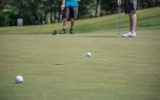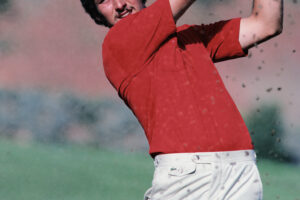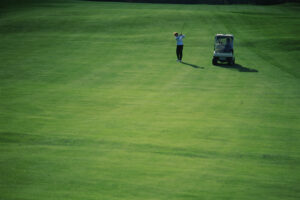Improve The Spine Angle In Your Golf Swing A common golf swing fault is a change in the spine angle during the phases of the golf swing. This single movement causes a chain reaction of compensations that alter the mechanics of your golf swing immensely. The result is usually inconsistency and a myriad of poor golf shots. Leading to frustration on the golf course and high scores.
The question that arises in my mind about this swing fault is; how can the amateur golfer improve their spine angle in the golf swing? The result would be an end to changes that oh so often hamper golfers of every level. Speaking with PGA Teaching professional Christopher Smith on this subject allowed me to get to one of the roots of this common swing fault.
According to Christopher Smith the changing of the spine angle is a common fault of the 1000’s of golfers he works with every year. A common spine angle change Christopher indicated to me was immediately at the beginning of the back swing. Often he views golfers who stand up during their back swing. This obviously changes their spine angle and not to mention posture. Resulting in a chain reaction of compensations in the golf swing.
Once Christopher demonstrated this common spine angle changed I immediately knew one of the “fixes” for it. Observation of Christopher performing this specific spine angle change of standing up during the back swing told me one important thing. This so-called swing fault of standing up may be better categorized as a flexibility fault.
Yes, a flexibility fault as I like to call it is when a golfer’s lack of flexibility impedes them from performing the mechanics of the golf swing correctly. Flexibility faults are often misdiagnosed as swing faults. As a result, the golfer dubiously works on fixing their golf swing with no avail. They continue to struggle with standing up during their back swing and never fix it or understand why it is happening. The reason is they are trying “fix” the problem with the incorrect medicine.
The correct medicine would be the implementation of golf flexibility exercises. This type of fix would allow the golfer in such a situation to perform the mechanics of the swing correctly without limitations in their body getting in the way. Sounds pretty simple when you map out in such a way.
Now getting back to the spine angle problem Christopher Smith was discussing. The standing up during the backswing can partly be described as a flexibility fault. In such a situation this is telling me the golfer has some flexibility issues limiting their ability to maintain the correct posture during the back swing. In such a situation (i.e. standing up during the backswing) we can pinpoint the flexibility fault to hip region of the body.
The hips need to be flexible and mobile to allow the golfer to maintain a fixed spine angle and rotate around it during the golf swing. If the hips are tight and inflexible the ability to do this will be compromised as in the example of standing up during the back swing.
Now looking specifically at the spine angle change of standing up we can even pin point to a greater extent the exact muscles in the hips causing this “flexibility fault”. Usually with a golfer that stands up during the backswing I find they have tight hip flexors. Hip flexors are muscles that run across the front part of the hip on both legs. These muscles when tight (i.e. inflexible) “pull” the hips underneath your spine. Making it almost impossible to maintain the spine angle set in the address position. Once you begin the back swing and suffer from “tight” hip flexors. These muscles will “pull your hips” underneath your spine, causing you to stand up. The end result is a change in your spine angle and a series of compensations in the golf swing to follow.
How do we fix this flexibility fault, get those tight hip flexors mobile, and improve your golf swing? Simply by adding a series of golf fitness flexibility exercises to your golf swing improvement program. These types of exercises take just a few minutes a day to perform. They will alleviate the tightness in your hips and in the long run improve your golf swing.
Simple yet very effective golf fitness flexibility exercises I like to use for tight hip flexors are the kneeling hip flexor stretch, standing quadriceps, and spider. All three of these golf fitness flexibility exercise focus on the hip flexors. Over time these flexibility exercises will lengthen (i.e. stretch) those tight hip flexors. Allowing you greater mobility in the hips and eliminate one of the reasons for standing up in the back swing.
So remember, it is necessary to maintain a fixed spine angle during the golf swing. If you do not a whole series of compensations will occur. The end result will be an inconsistent golf swing. One such reason for a change in your spine angle may be standing up during the back swing. This swing fault is often a flexibility fault resulting from tight hips. The implementation of golf fitness flexibility exercises in a short amount of time can fix this flexibility fault and stop you from standing up during the back swing. Resulting in a more consistent golf swing. Keep in mind the connection between your body and the golf swing, and realize it is the body swinging the golf club




![golfer-1960998_960_720[1]](https://helpinggolfers.com/wp-content/uploads/2017/11/golfer-1960998_960_7201-300x200.jpg)
![golf-swing-970892_960_720[1]](https://helpinggolfers.com/wp-content/uploads/2017/11/golf-swing-970892_960_7201-300x200.jpg)
![person-1284011_960_720[1]](https://helpinggolfers.com/wp-content/uploads/2017/11/person-1284011_960_7201-300x200.jpg)





Appreciate the recommendation. Will try it out.
I think the admin of this website is genuinely working hard for his web
site, for the reason that here every stuff is quality based material.
It’s in point of fact a great and useful piece of
information. I’m satisfied that you shared this helpful
information with us. Please stay us informed like this. Thanks
for sharing.
Very soon this site will be famous among all blogging
viewers, due to it’s fastidious posts
Hello there, just became alert to your blog through Google, and found that it’s really informative.
I’m gonna watch out for brussels. I will appreciate if you continue this in future.
Numerous people will be benefited from your writing.
Cheers!
We’re a bunch of volunteers and starting a brand new scheme in our community.
Your site offered us with valuable information to work
on. You have performed an impressive process and our whole group shall
be thankful to you.
Amazing blog! Do you have any tips and hints for aspiring writers?
I’m planning to start my own blog soon but I’m a little lost on everything.
Would you advise starting with a free platform like WordPress or go for a paid option? There are so many
options out there that I’m completely overwhelmed ..
Any ideas? Kudos!
Great post. I used to be checking continuously this blog and I am inspired!
Very helpful information specially the ultimate part
🙂 I take care of such info a lot. I used to be looking
for this particular information for a long time.
Thanks and best of luck.
Hi, just wanted to say, I loved this blog post. It was helpful.
Keep on posting!
Can I just say what a comfort to discover a person that truly
understands what they’re discussing online. You definitely
know how to bring a problem to light and make it important.
A lot more people must look at this and understand this side of your story.
It’s surprising you are not more popular because you most certainly possess the gift.
Thanks for one’s marvelous posting! I seriously enjoyed reading it, you
happen to be a great author.I will remember to
bookmark your blog and will often come back very soon. I want
to encourage you to ultimately continue your great posts, have a nice weekend!
I am now not positive where you’re getting your info, but
good topic. I needs to spend some time finding
out much more or understanding more. Thanks for great info I used
to be looking for this info for my mission.
I like the helpful info you provide in your articles.
I’ll bookmark your blog and check again here regularly.
I’m quite sure I will learn a lot of new stuff right here!
Best of luck for the next!
I am truly glad to read this webpage posts which contains tons of helpful data, thanks for
providing these kinds of information.
Today, while I was at work, my sister stole
my iphone and tested to see if it can survive a 30 foot drop, just
so she can be a youtube sensation. My apple ipad is now destroyed and
she has 83 views. I know this is completely off topic but I had to share
it with someone!
Oh my goodness! Incredible article dude! Thanks, However I am encountering problems with your
RSS. I don’t know the reason why I can’t subscribe to it.
Is there anybody having the same RSS problems?
Anyone that knows the solution will you kindly respond?
Thanks!!
First of all I would like to say superb blog!
I had a quick question that I’d like to ask if you
don’t mind. I was curious to know how you center yourself and
clear your head prior to writing. I’ve had a difficult time clearing my thoughts in getting my ideas out there.
I truly do take pleasure in writing however it just seems like the first
10 to 15 minutes tend to be wasted just trying to figure out how to begin. Any suggestions or tips?
Cheers!
Hello just wanted to give you a quick heads up.
The text in your content seem to be running off the screen in Chrome.
I’m not sure if this is a format issue or something to
do with internet browser compatibility but I figured I’d post to let
you know. The style and design look great though! Hope you get the problem resolved soon. Many
thanks
I quite like looking through an article that can make people think.
Also, many thanks for allowing me to comment!
Howdy, I believe your site could possibly be having browser compatibility issues.
Whenever I look at your website in Safari, it looks
fine however when opening in I.E., it’s got some
overlapping issues. I just wanted to give you a quick heads up!
Other than that, fantastic site!
Ahaa, its good conversation concerning this article at this place at
this weblog, I have read all that, so now me also
commenting here.
I really like reading through an article that will make men and women think.
Also, thanks for allowing for me to comment!
Wow! After all I got a website from where I can in fact get useful information regarding my study and knowledge.
I all the time used to study paragraph in news papers but
now as I am a user of net therefore from now I am using net for posts, thanks to web.
Asking questions are genuinely good thing if you are not understanding something completely,
however this post presents pleasant understanding even.
Hey There. I found your blog the use of msn. This
is a really smartly written article. I’ll be sure to bookmark it and come back to learn more of your helpful
information. Thanks for the post. I’ll certainly comeback.
Hey there! I know this is kind of off-topic but I had to ask.
Does managing a well-established blog such as yours take a
massive amount work? I am brand new to writing a blog however
I do write in my diary on a daily basis. I’d like to start a blog so I can easily share my personal experience and
feelings online. Please let me know if you have any kind of
ideas or tips for brand new aspiring blog owners. Appreciate it!
I don’t even know how I ended up here, but I thought this post was great.
I don’t know who you are but definitely you are going to a famous blogger if you are
not already 😉 Cheers!
I’m really enjoying the theme/design of your website.
Do you ever run into any internet browser compatibility
issues? A number of my blog audience have complained about my blog not working correctly in Explorer
but looks great in Opera. Do you have any suggestions to help fix this issue?
My brother suggested I would possibly like this web
site. He was totally right. This publish truly made my day.
You cann’t believe just how much time I had spent for this information! Thanks!
Excellent beat ! I wish to apprentice while you
amend your website, how can i subscribe for a blog website?
The account helped me a acceptable deal. I had been a little
bit acquainted of this your broadcast provided bright clear
idea
An impressive share! I’ve just forwarded this onto a colleague who had been doing a little research on this.
And he in fact bought me lunch simply because I
stumbled upon it for him… lol. So let me reword this….
Thanks for the meal!! But yeah, thanx for spending the time
to discuss this matter here on your web site.
Hello! I know this is kinda off topic nevertheless I’d figured I’d ask.
Would you be interested in exchanging links or maybe guest writing
a blog article or vice-versa? My site addresses a lot of the same subjects as yours and I
feel we could greatly benefit from each other. If you’re interested feel free to shoot me an email.
I look forward to hearing from you! Wonderful blog by
the way!